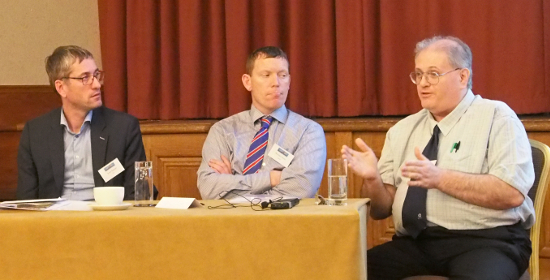RuminOmics reaches out to industry
Efficiency of production provides the answer, not only to greater profitability, but also to reducing carbon footprint and greenhouse gas (GHG) emissions, according to the expert speakers at a RuminOmics workshop organised by Quality Meat Scotland (QMS) in Edinburgh. The meeting attracted around 70 delegates from 12 countries representing a wide interest in the subject of solving the challenge of emissions from livestock systems.
Professor Cled Thomas (EAAP) stated that the positive effect on the environment of livestock was too often forgotten about but that intensification has resulted in negative effects. One of the major areas of discussion at the workshop was whether GHG emissions could be reduced through livestock breeding programmes. Professor Thomas highlighted a range of mitigation strategies that farmers may adopt to reduce GHG, ranging from feed additives to breeding. Unless mitigations resulted in increased profit, they were unlikely to be used in practice. Breeding, he said, offered the greatest potential to reduce methane which was the principal emissions in ruminant systems. However, data from the RuminOmics project demonstrating that selecting cows with low methane emissions could result in reduced efficiency. Better to aim for improved efficiency was his conclusion.
Dr Jimmy Hyslop, Beef Specialist with SAC Consulting, part of SRUC, believed the focus should be on output per unit of fixed costs “It is quite simple really; profit equals income less costs, and efficiency is the route to profits, which in turn will lead to lower GHG emissions,” said Dr Hyslop.

Speakers respond to questions from the audience during the Round Table Discussion.
Much of the work done by scientists on the RuminOmics team has been within the dairy industry and delegates were given a fascinating comparison of the Dutch and Irish systems by Dr Brendan Horen of Teagasc, and Dr Erwin Koenan of CRV, a large co-operative cattle improvement organisation owned by Dutch and Flemish farmers. Both systems have government production and environmental impact targets to meet but they do it in very different ways. Dr Koenen explained that in an era without milk quotas, many Dutch farmers want to increase milk production to meet the increasing global demand for dairy products, but to comply with government legislation on reductions on fertilisers, concentrates, manure application and GHG emissions they will have to rely on new management and breeding tools. He said, “To identify bulls producing more efficient daughters, CRV has developed a new breeding index based on breeding values for the main traits affecting production efficiency, this leads to increased profitability and lower methane emissions.”
On the other hand, in Ireland’s milk from forage systems, stocking rate is the main driver of productivity but the challenge here comes from environmental impact. Brendan said that a resilient, efficient system insulated from price volatility was the key. The strategy is to increase milk production by 50% over the next 15 years. Dr Horen stated, “Irish farmers need to select cows suitable for a grass system, requiring traits such as longevity, able to withstand feed fluctuations and large herd situations. Desirable traits have swung away from milk production to fertility, ease of calving and new traits such as ease of management.”
Interestingly, one of the RuminOmics studies, according to Professor Kevin Shingfield from IBERS, Aberystwyth University, indicated that producing higher quality grass silages and decreasing the reliance on concentrate supplements can maintain performance but suggested that GHG emissions were lower from a grass-based system. He said the project had brought them much closer to understanding why when fed the same diet some cows emit more GHG than others.
******
This is a summary of the QMS press release on 19 November 2015. For the full press release on the event, visit here.
